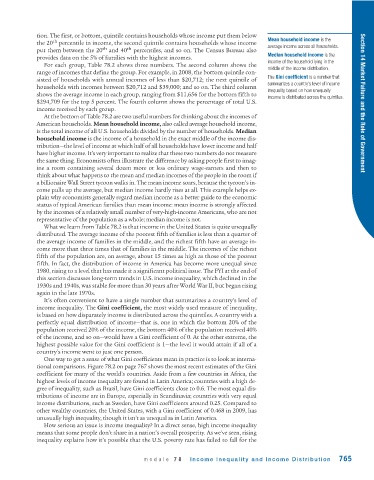Page 807 - Krugmans Economics for AP Text Book_Neat
P. 807
tion. The first, or bottom, quintile contains households whose income put them below Mean household income is the
th
the 20 percentile in income, the second quintile contains households whose income average income across all households.
put them between the 20 th and 40 th percentiles, and so on. The Census Bureau also
Median household income is the
provides data on the 5% of families with the highest incomes.
income of the household lying in the
For each group, Table 78.2 shows three numbers. The second column shows the
middle of the income distribution.
range of incomes that define the group. For example, in 2008, the bottom quintile con-
The Gini coefficient is a number that
sisted of households with annual incomes of less than $20,712; the next quintile of
summarizes a country’s level of income
households with incomes between $20,712 and $39,000; and so on. The third column
inequality based on how unequally
shows the average income in each group, ranging from $11,656 for the bottom fifth to
income is distributed across the quintiles.
$294,709 for the top 5 percent. The fourth column shows the percentage of total U.S. Section 14 Market Failure and the Role of Government
income received by each group.
At the bottom of Table 78.2 are two useful numbers for thinking about the incomes of
American households. Mean household income, also called average household income,
is the total income of all U.S. households divided by the number of households. Median
household income is the income of a household in the exact middle of the income dis-
tribution—the level of income at which half of all households have lower income and half
have higher income. It’s very important to realize that these two numbers do not measure
the same thing. Economists often illustrate the difference by asking people first to imag-
ine a room containing several dozen more or less ordinary wage-earners and then to
think about what happens to the mean and median incomes of the people in the room if
a billionaire Wall Street tycoon walks in. The mean income soars, because the tycoon’s in-
come pulls up the average, but median income hardly rises at all. This example helps ex-
plain why economists generally regard median income as a better guide to the economic
status of typical American families than mean income: mean income is strongly affected
by the incomes of a relatively small number of very-high-income Americans, who are not
representative of the population as a whole; median income is not.
What we learn from Table 78.2 is that income in the United States is quite unequally
distributed. The average income of the poorest fifth of families is less than a quarter of
the average income of families in the middle, and the richest fifth have an average in-
come more than three times that of families in the middle. The incomes of the richest
fifth of the population are, on average, about 15 times as high as those of the poorest
fifth. In fact, the distribution of income in America has become more unequal since
1980, rising to a level that has made it a significant political issue. The FYI at the end of
this section discusses long-term trends in U.S. income inequality, which declined in the
1930s and 1940s, was stable for more than 30 years after World War II, but began rising
again in the late 1970s.
It’s often convenient to have a single number that summarizes a country’s level of
income inequality. The Gini coefficient, the most widely used measure of inequality,
is based on how disparately income is distributed across the quintiles. A country with a
perfectly equal distribution of income—that is, one in which the bottom 20% of the
population received 20% of the income, the bottom 40% of the population received 40%
of the income, and so on—would have a Gini coefficient of 0. At the other extreme, the
highest possible value for the Gini coefficient is 1—the level it would attain if all of a
country’s income went to just one person.
One way to get a sense of what Gini coefficients mean in practice is to look at interna-
tional comparisons. Figure 78.2 on page 767 shows the most recent estimates of the Gini
coefficient for many of the world’s countries. Aside from a few countries in Africa, the
highest levels of income inequality are found in Latin America; countries with a high de-
gree of inequality, such as Brazil, have Gini coefficients close to 0.6. The most equal dis-
tributions of income are in Europe, especially in Scandinavia; countries with very equal
income distributions, such as Sweden, have Gini coefficients around 0.25. Compared to
other wealthy countries, the United States, with a Gini coefficient of 0.468 in 2009, has
unusually high inequality, though it isn’t as unequal as in Latin America.
How serious an issue is income inequality? In a direct sense, high income inequality
means that some people don’t share in a nation’s overall prosperity. As we’ve seen, rising
inequality explains how it’s possible that the U.S. poverty rate has failed to fall for the
module 78 Income Inequality and Income Distribution 765

